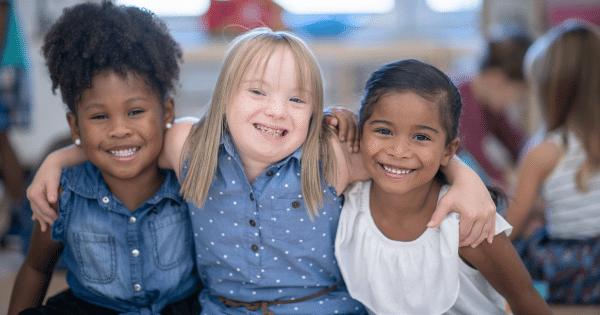Creating Inclusive and Responsive Classrooms

Before you head into your classroom today, take a few minutes to pause and stand at the entrance to your room.
What is the view from your door?
What do you notice?
Ask yourself:
How does the room make you feel?
Does the environment spark joy for you and your students?
Hopefully, it’s an inviting place to play and learn.
Would a young child spending many hours in the room have similar feelings?
Consider these ideas to create an environment that is responsive to and inclusive of all the young children in your early childhood classroom.
- Arrange and present materials to children in ways that invite and encourage play.
- Organize and store materials so they are accessible for all
- Use clear containers labeled with pictures and words in the languages spoken in your room.
- Label the shelves for easy cleanup and consistency in storage.
- Attractively display items that will entice children to explore and develop agency in their play.
- Intentionally arrange items on trays and in interesting containers.
- Trust children to make choices that will engage them in play.
- Aim for flexibility in your room arrangement- this allows children to explore and opens up opportunities for experiences to happen through discovery during free play.
- Create spaces for small groups to engage in cooperative play.
- Include spaces for individual exploration.
- Design spaces that allow for extended and sustained play.
- Create spaces for small groups to engage in cooperative play.
- Organize and store materials so they are accessible for all
- Choose materials that will pique the interest of the children. Walk around your room and take notice of the books, materials, and toys in the different interest areas. Will the children see themselves authentically reflected in these items?
- Spend time getting to know your children and their families so you can choose materials that reflect their interests, cultures, languages, and developmental abilities.
- Include visual representations throughout your room by adding puzzles and books of the children and their families participating in everyday activities - in the classroom, at home, and in the community.
- Include a variety of materials within a range of ability levels. This allows children to experience success and also be challenged.
- Consider open-ended materials that encourage children to use their imagination and creativity as they extend their play.
- Spend time getting to know your children and their families so you can choose materials that reflect their interests, cultures, languages, and developmental abilities.
- Provide materials that encourage children to explore through multiple senses. Young children learn best when multiple senses are involved.
- Include natural products that feel good to the touch.
- Consider easily washed textiles and tactile materials to provide children with sensory input.
- Choose musical instruments that are easy to handle and also reflect the cultures of the children and their families.
- Include visual representations throughout your room by adding puzzles and books of the children and their families participating in everyday activities - in the classroom, at home, and in the community.
- Add scented dough to the sensory table. It feels good, looks good, and smells good too.
- Include natural products that feel good to the touch.
Setting up your classroom to meet the needs of all your students can be challenging. Take small steps into the room. Slowly create spaces and add materials as you get to know your children and their families. Invite the families to contribute to the learning environment. Before you know it, your classroom will be a nurturing, supportive, and responsive space where joyful learning and play can be viewed from the door!
-----
Kathy Trainor, Ed.D. brings decades of early childhood education experience to her work as an adjunct professor at Arcadia University and currently the Educational Specialist at Becker’s School Supplies. She is a graduate of Arcadia University with an Ed.D. in Special Education and a Master of Arts in Early Education. Prior to teaching in higher education, Kathy was a preschool teacher for over 20 years. Kathy is a mom to five grown children and a grandmother to seven amazing grandchildren who keep her active and smiling every day.
